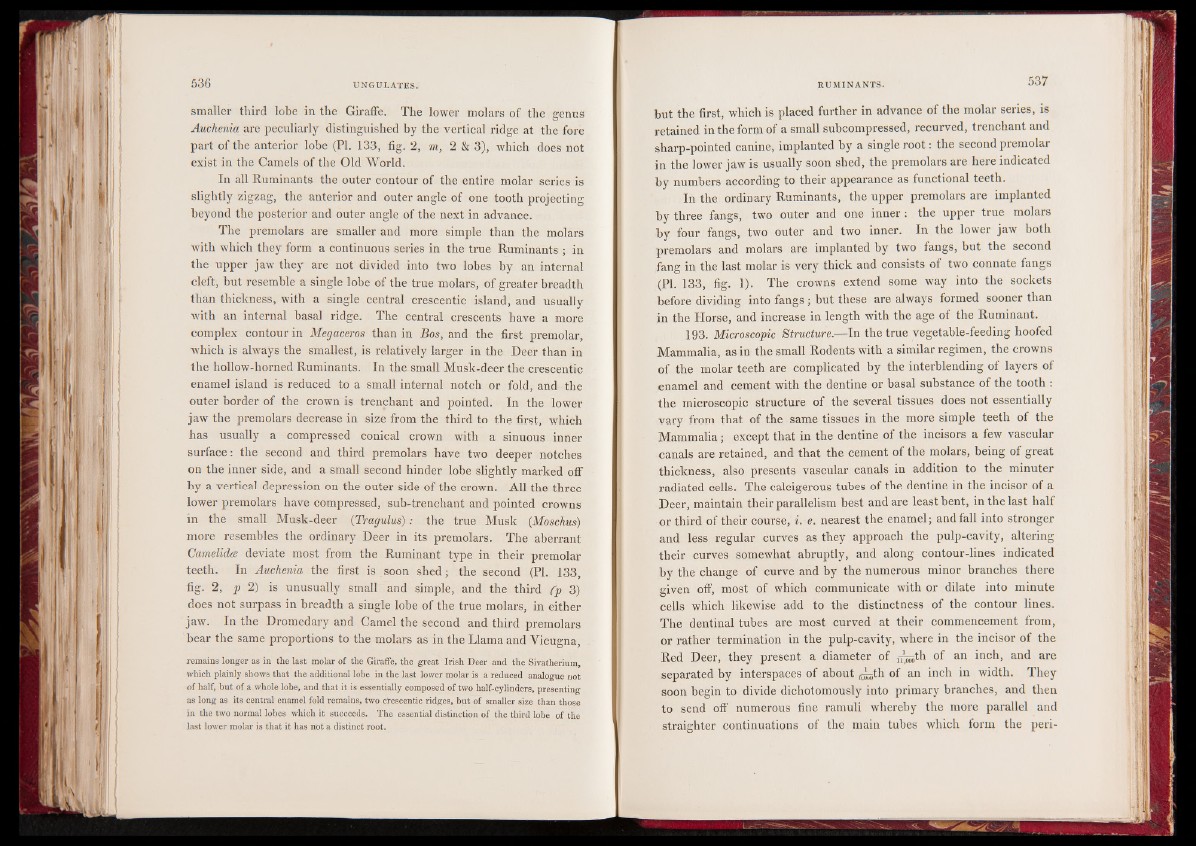
smaller third lobe in the Giraffe. The lower molars of the genus
Auchenia are peculiarly distinguished hy the vertical ridge at the fore
part of the anterior lobe (PI. 133, fig. 2, m, 2 & 3), which does not
exist in the Camels of the Old World.
In all Ruminants the outer contour of the entire molar series is
slightly zigzag, the anterior and outer angle of one tooth projecting
beyond the posterior and outer angle of the next in advance.
The premolars are smaller and more simple than the molars
with which they form a continuous series in the true Ruminants ; in
the upper jaw they are not divided into two lobes by an internal
cleft, hut resemble a single lobe of the true molars, of greater breadth
than thickness, with a single central crescentic island, and usually
with an internal basal ridge. The central crescents have a more
complex contour in Megaceros than in Bos, and the first premolar,
which is always the smallest, is relatively larger in the Deer than in
the hollow-horned Ruminants. In the small Musk-deer the crescentic
enamel island is reduced to a small internal notch or fold, and the
outer border of the crown is trenchant and pointed. In the lower
jaw the premolars decrease in size from the third to the first, which
has usually a compressed conical crown with a sinuous inner
surface: the second and third premolars have two deeper notches
on the inner side, and a small second hinder lobe slightly marked off
by a vertical depression on the outer side of the crown. All the three
lower premolars have compressed, sub-trenchant and pointed crowns
in the small Musk-deer (Tragulus).- the true Musk (Moschus)
more resembles the ordinary Deer in its premolars. The aberrant
Camelidce deviate most from the Ruminant type in their premolar
teeth. In Auchenia the first is soon shed; the second (PI. 133,
fig. 2, p 2) is unusually small and simple, and the third Cp 3)
does not surpass in breadth a single lobe of the true molars, in either
jaw. In the Dromedary and Camel the second and third premolars
bear the same proportions to the molars as in the Llama and Vicugna,
remains longer as in the last molar of the Giraffe, the great Irish Deer and the Sivatherium,
which plainly shows that the additional lobe in the last lower molar is a reduced analogue not
of half, hut of a whole lobe, and that it is essentially composed of two half-cylinders, presenting
as long as its central enamel fold remains, two crescentic ridges, but of smaller size than those
in the two normal lobes which it succeeds. The essential distinction of the third lobe of the
last lower molar is that it has not a distinct root.
but the first, which is placed further in advance of the molar series, is
retained in the form of a small suheompressed, recurved, trenchant and
sharp-pointed canine, implanted by a single root c the second premolar
in the lower jaw is usually soon shed, the premolars are here indicated
by numbers according to their appearance as functional teeth.
In the ordinary Ruminants, the upper premolars are implanted
by three fangs, two outer and one inner: the upper true molars
by four fangs, two outer and two inner. In the lower jaw both
premolars and molars are implanted by two fangs, but the second
fang in the last molar is very thick and consists of two connate fangs
(PI. 133, fig. 1). The crowns extend some way into the sockets
before dividing into fangs ; but these are always formed sooner than
in the Horse, and increase in length with the age of the Ruminant.
193. Microscopic Structure.—In the true vegetable-feeding hoofed
Mammalia, as in the small Rodents with a similar regimen, the crowns
of the molar teeth are complicated by the interblending of layers of
enamel and cement with the dentine or basal substance of the tooth :
the microscopic structure of the several tissues does not essentially
vary from that of the same tissues in the more simple teeth of the
Mammalia; except that in the dentine of the incisors a few vascular
canals are retained, and that the cement of the molars, being of great
thickness, also presents vascular canals in addition to the minuter
radiated cells. The calcigerous tubes of the dentine in the incisor of a
Deer, maintain their parallelism best and are least bent, in the last half
or third of their course, i. e. nearest the enamel; and fall into stronger
and less regular curves as they approach the pulp-cavity, altering
their curves somewhat abruptly, and along contour-lines indicated
by the change of curve and by the numerous minor branches there
given off, most of which communicate with or dilate into minute
cells which likewise add to the distinctness of the contour lines.
The dentinal tubes are most curved at their commencement from,
or rather termination in the pulp-cavity, where in the incisor of the
Red Deer, they present a diameter of j-^th of an inch, and are
separated hy interspaces of about e-L;th 0f an inch in width. They
soon begin to divide dichotomously into primary branches, and then
to send off numerous fine ramuli whereby the more parallel and
straighter continuations of the main tubes which form the peri